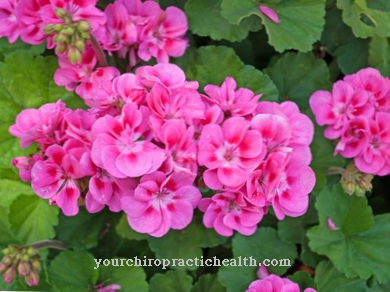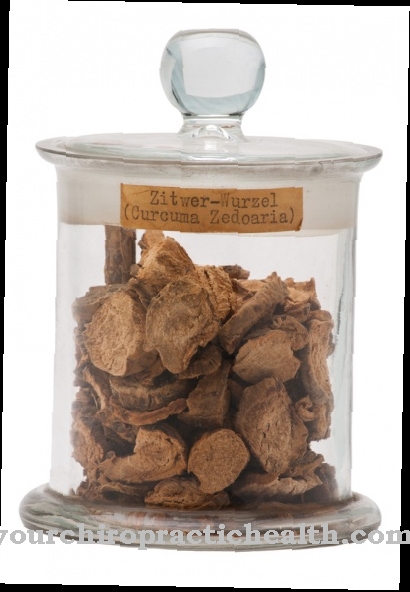The Horsetail is a medicinal plant from the horsetail family. It is used, among other things, for a bladder infection.
Occurrence & cultivation of horsetail

The name horsetail can also be traced back to the plant's use as a cleaning agent for pewter items. The silicic acid that is inside the plant has the effect of a cleaning body. For this reason, the importance of the horsetail as a medicinal plant was temporarily forgotten. Its healing properties were valued by Greek and Roman doctors in ancient times.
Horsetail is a perennial that grows best in moist soil or in water. Most often it grows in fields, fields and roadsides. The roots of the medicinal plant can reach up to 1.60 meters deep into the ground. The outward height is between 10 and 50 centimeters. The green shoots reach an average thickness between 3 and 5 millimeters. A typical distinguishing feature of the horsetail is its upright, lively branches.
Horsetail is native to the European continent and the north of Asia. There the plant primarily prefers sunny locations with loamy soils. But there are also horsetail specimens in Australia, New Zealand and South Africa. The horsetail has some high quality ingredients. These are silica, vegetable acids, flavonoids, carboxylic acids, potassium and glycosides. These substances are considered valuable from a medical point of view.
While farmers classify the field horsetail as a weed, other people value it as a medicinal plant. His supporters also included the Bavarian priest and hydrotherapist Sebastian Kneipp (1821-1897), who said the herb had a healing effect on tumors. The positive effect of the horsetail was also confirmed by the herbalist Maria Treben (1907-1993) and the plant biologist Richard Willfort (1905-1978).
Effect & application
The positive effect of the horsetail can be attributed to its health-promoting ingredients. These are suitable for treating various ailments and diseases. In order to use the medicinal plant, the sterile young shoots that form in the spring and summer months are harvested. The harvest time is usually between May and August.
The upper sections of the plant shoots are of particular importance. They need special treatment in order to be able to develop the healing properties of the plant ingredients. The collected shoots are air dried. After cutting them into small pieces, the useful parts of the plant can be poured over with hot water and prepared as tea.
The ingredients of horsetail have the property of having a diuretic effect. In this way, the urinary tract, such as the bladder, urethra and ureter, can be thoroughly flushed, which means that harmful germs are flushed out. This is why horsetail is particularly suitable for treating inflammatory urinary tract infections.
Horsetail is also often used as a component of bladder teas or kidney teas. Further positive properties are a blood-purifying, hemostatic, expectorant, astringent and strengthening effect. Horsetail is also considered to be helpful for disorders of the magnesium balance. Because the horsetail can easily be confused with the poisonous marsh horsetail, it is advisable not to collect the plant yourself.
Importance for health, treatment & prevention
Horsetail was used in folk medicine centuries ago. This used the medicinal plant against a wide variety of complaints. These included gastric bleeding, gout, osteoporosis, rheumatism, dry skin, eczema, oral mucosal infections, bleeding gums, broken bones and hair loss.
In addition, patients took baths and washes with horsetail if they suffered from beard lichen, wounds, nail bed infections, hemorrhoids, or open legs. The herb was even used against cancerous ulcers.
Today the field horsetail is primarily used to treat urinary tract infections and to flush the kidneys. For this purpose, the patient takes the horsetail in the form of tea. He puts ¼ liter of boiling water on two teaspoons of horsetail. After the tea mixture has steeped for 30 minutes, it is filtered off and taken five times a day.
In this way, the excretion of urine and thus also of harmful germs can be accelerated. However, it is not recommended to take horsetail tea if the patient suffers from functional disorders of the heart, kidneys or edema (water retention in the body).
Another area of application for horsetail is the treatment of flatulence. To do this, a warm pad is placed on the stomach for half an hour. In the case of urinary tract infections, the patient places the pad on the kidneys. However, to avoid scalding, the overlay must not be too hot. Against a cold, tea with horsetail can also be used as a nasal rinse. A hip bath with horsetail is considered helpful against cystitis, prostate ailments, rheumatism or varicose veins.
For the bath, 50 grams of dried horsetail are added to one liter of cold water. This mixture stays overnight. The next day, the horsetail is filtered out. The patient mixes the remaining liquid with his bath water. He then takes a hip bath for around 15 minutes and then rests for an hour. In addition, horsetail wraps can be helpful against ulcers, eczema, and tendinitis and bursitis.




























